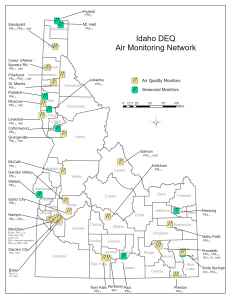DEQ’s Air Quality Monitoring Program consists of various instruments at more than 30 sites statewide used to assess ambient concentrations of select air pollutants, also known as criteria pollutants. We also collect meteorological data to further define characteristics affecting air quality and conduct regular quality assurance activities to ensure data integrity.
Data are used for many purposes:
- Determining compliance with National Ambient Air Quality Standards (NAAQS)
- Determining the locations of maximum pollutant concentrations
- Forecasting air quality to determine the Air Quality Index (AQI)
- Providing early detection of smoke impacts
- Determining the effectiveness of air pollution control programs
- Evaluating the effects of air pollution levels on public health
- Tracking the progress of state implementation plans
- Supporting pollutant dispersion models
- Developing responsible, cost-effective air pollution control strategies
- Analyzing air quality trends
We distribute air quality data via DEQ’s real-time map and EPA’s AirNow and AirData web pages. Data are sent hourly to the real-time map and AirNow and both hourly and quarterly to AirData. Quarterly AirData information undergoes validation and quality control review by our staff. Data appear in various formats on these web pages and can be used in a multitude of ways.
Our monitoring stations provide essential air quality data but do not cover the entire state. Low-cost alternative sensors are available for public use but continue to undergo lab and field tests to identify true performance characteristics. In August 2020, EPA initiated a pilot project to convey and further assess low-cost sensor data. The data are found at https://fire.airnow.gov/#. We do not incorporate low-cost sensors into our monitoring network, but we continue to evaluate opportunities to use these sensors. See DEQ’s low-cost sensor bulletin for additional information.
This accordion will not appear on the screen
 DEQ monitors air pollutants at over 30 sites throughout the state. Nine sites assist with smoke management through the Crop Residue Burning program and are operated seasonally (highlighted in green). The remaining sites (highlighted in yellow) capture and report data year-round. Monitor locations are based on specific monitoring objectives. For more information, refer to the annual network plans and 5-year assessments below.
DEQ monitors air pollutants at over 30 sites throughout the state. Nine sites assist with smoke management through the Crop Residue Burning program and are operated seasonally (highlighted in green). The remaining sites (highlighted in yellow) capture and report data year-round. Monitor locations are based on specific monitoring objectives. For more information, refer to the annual network plans and 5-year assessments below.
DEQ publishes an annual network plan documenting monitoring network objectives and identifying modifications to the network. Our plan identifies changes made to the monitoring network in the intervening year and proposed changes for the following year. We publish the plan for public review each year and then submit it to EPA. EPA identifies any deficiencies, which DEQ addresses.
DEQ’s 5-year network assessment provides a comprehensive analysis of our monitoring network and explains the criteria we used to choose monitoring sites (e.g., emissions, population, and meteorology). We submit assessments to EPA on a 5-year cycle.
DEQ publishes annual data summary reports to inform the public of air quality throughout Idaho. These reports summarize regional air quality and present air monitoring results for six criteria air pollutants.
DEQ’s quality management system (QMS) is a formalized collection of processes, documents, and procedures used to ensure that air quality and meteorological data meet required standards. The QMS ensures that we collect and report the highest quality data to support informed decision-making.
DEQ’s quality management plan is a component of the QMS that documents our overall quality assurance policies, procedures, roles, and responsibilities. Individual projects follow a Quality Assurance Project Plan that describes the necessary quality control activities that must be implemented to ensure project results satisfy performance criteria.
Air quality data collection projects also follow standard operating procedures (SOPs) to ensure that monitors provide the highest quality data on an ongoing basis. These SOPs guide our data collection, review, and submittal process.

